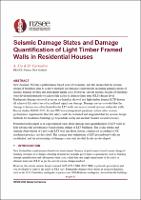| dc.contributor.author | Liu, Angela | |
| dc.contributor.author | Carradine, David | |
| dc.date.accessioned | 2023-08-28T04:23:29Z | |
| dc.date.available | 2023-08-28T04:23:29Z | |
| dc.date.issued | 2023-04-19 | |
| dc.identifier.uri | https://repo.nzsee.org.nz/xmlui/handle/nzsee/2591 | |
| dc.description.abstract | New Zealand (NZ) has a performance-based code environment. The essence of performance-based seismic design of buildings is to achieve multiple performance requirements including damage control. However, the current seismic designs of buildings were developed primarily to achieve life safety at ultimate limit state (ULS).
Earthquake damage observed in recent earthquakes showed that the buildings designed to modern codes, although likely to achieve life safety in a major event, could have significant damage. The MBIE Seismic Risk Working Group’s report (2020) identified significant gaps in the building seismic performance regime and raised important questions on how seismic performance could be measured. A recent study about societal expectations for seismic performance of buildings provided further impetus for the seismic design methods for residential buildings to go beyond life safety and include broader societal recovery.
Most residential buildings in NZ are low-rise light timber framed (LTF) buildings where both the gravity load-resisting systems and lateral load resisting systems are LTF walls, which are often sheathed using plasterboard.
Presented in this paper is an experimental study about cyclic behaviour and damage state quantification of LTF walls sheathed with plywood and plasterboard as a step to help advance the performance-based seismic design of LTF buildings. The cyclic testing and damage observations of a full-scale test specimen including LTF walls and timber floor diaphragm are described. The damage state definitions of LTF plasterboard walls are established, and the relationships of damage states with the drift levels are established. | |
| dc.language.iso | en | |
| dc.publisher | New Zealand Society for Earthquake Engineering | |
| dc.relation.ispartofseries | 2023;87 | |
| dc.subject | Quantifying and addressing uncertainties in seismic design | |
| dc.title | Seismic Damage States and Damage Quantification of Light Timber Framed Walls in Residential Houses | |
| dc.type | Article | |

